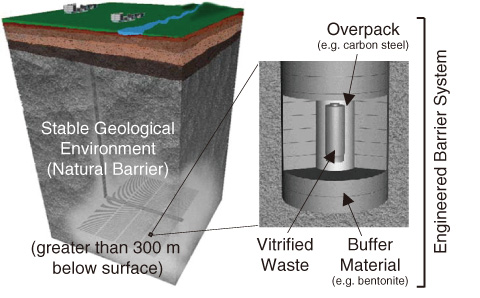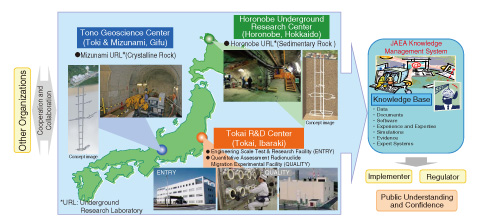
Fig.3-1 Basic concept of geological disposal of high-level radioactive waste in Japan

Fig.3-2 Japan Atomic Energy Agency’s R&D activities
Geological disposal is one of the options for isolating high-level radioactive waste (HLW) produced during nuclear power generation from human environments over a long period of time. This is an issue that remains critical in spite of the revision of the national nuclear energy policy and one that must now be dealt with by the present generation. In Japan, spent fuel from power reactors is reprocessed to extract reusable uranium and plutonium for power generation purposes. The liquids separated from the spent fuel during chemical reprocessing are solidified into a stable glass form. According to the Japanese concept, vitrified wastes are encapsulated in a thick steel overpack, which is surrounded by highly compacted bentonite and placed in a stable geological environment below 300 m (Fig.3-1). Geological disposal of HLW will be a long-term project lasting more than 100 years. The project begins with site selection, continues to repository construction and operation, which will be followed by post-closure monitoring. It is thus very important to proceed with the project efficiently, as a national responsibility, by continuously reinforcing the technical base and, more importantly, building public confidence. To this end, we have made and continue to make steady progress in research and development (R&D) in various fields, such as geoscientific research, engineering technology, and safety assessment, to improve the technology used for and reliability of geological disposal in Japan. Our efforts are also focused on promoting public understanding through the dissemination of relevant information and on opening our R&D facilities to the public.
A particular focus of our current R&D is on projects at two underground research laboratories (URLs)-one at Mizunami for research on crystalline rocks and the other at Horonobe for research on sedimentary formations (Fig.3-2)-with the main aim of developing a sound technical basis for the formulation and implementation of safety regulations. In March 2013, shaft excavation reached a depth of 500 m at Mizunami and 350 m at Horonobe, and some research galleries were made available for use. Multidisciplinary investigations are ongoing, as the reliability of a variety of investigative techniques should be tested and confirmed before site characterization begins in earnest (Topics 3-1, 3-2, 3-3, 3-4). Underground tunnels serve as a place for the public to experience deep geological environments first-hand and appreciate our R&D activities. In addition, studies on tectonics, volcanic and faulting activities, and so on have been underway for evaluating the long-term stability of geological environments in Japan (Topic 3-5).
In parallel with this geoscientific research, we are conducting an extensive study for performance assessment of multibarrier systems, engineered barrier systems, and long-term chemical and migration behavior of radionuclides at Tokai to improve geological disposal technology (Topics 3-6, 3-7, 3-8).
These studies involve the use of geological environment data obtained at both URLs. A prototype knowledge management system that was developed in 2009 has been improved to systematically provide multiple lines of evidence and R&D results. In 2012, the Information Synthesis and Interpretation System (ISIS), which supports the implementer in planning, performing, and evaluating the preliminary investigation, was developed by integrating each expert system, using the experience and know-how that experts have garnered through R&D activities.